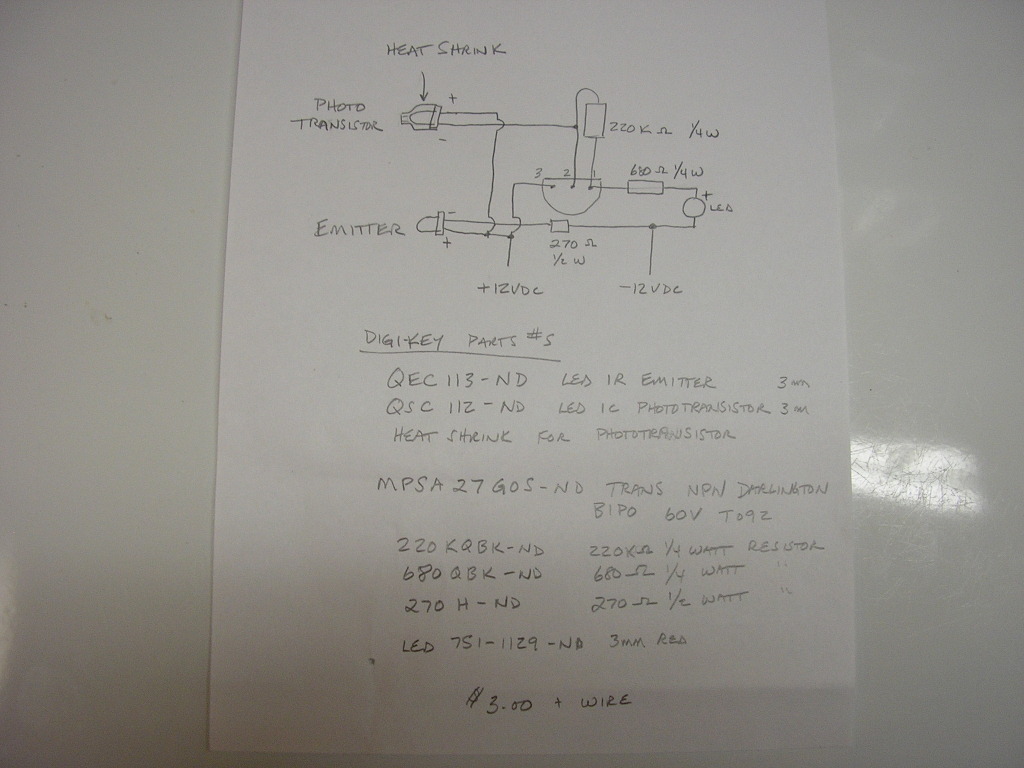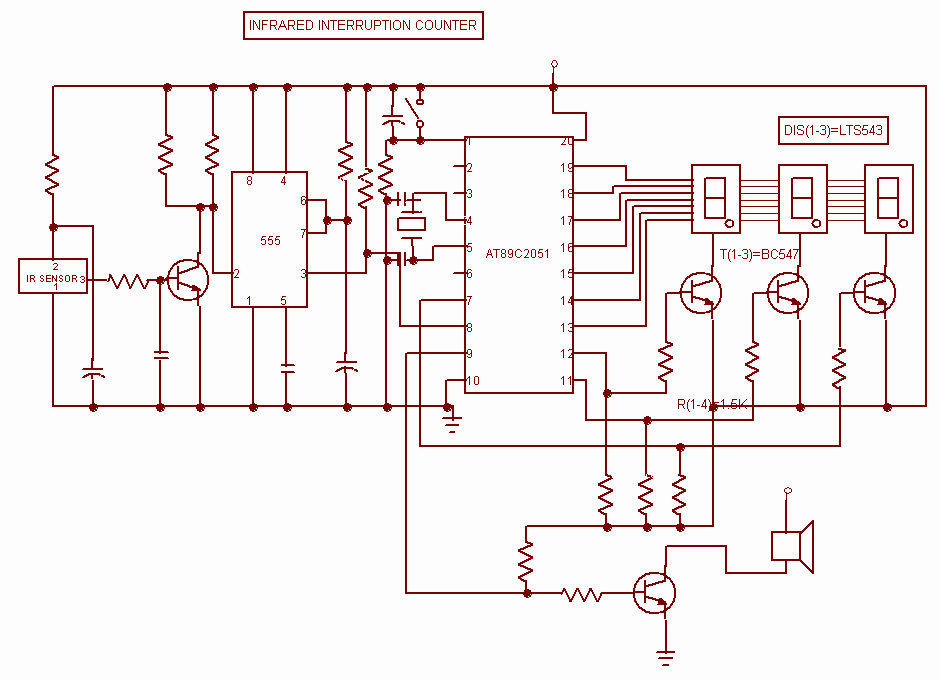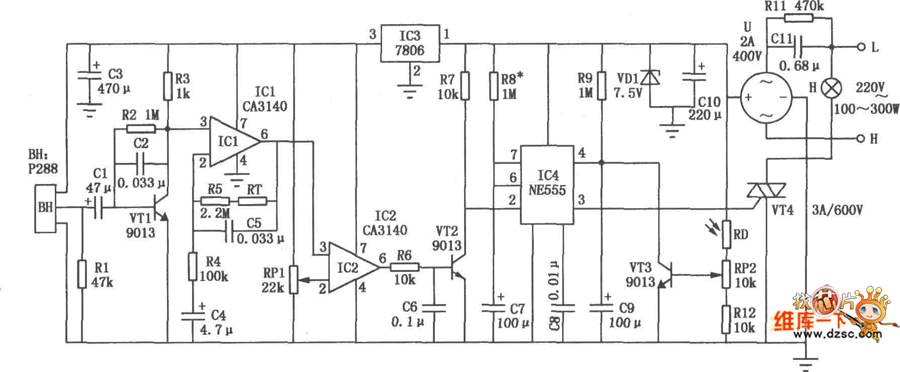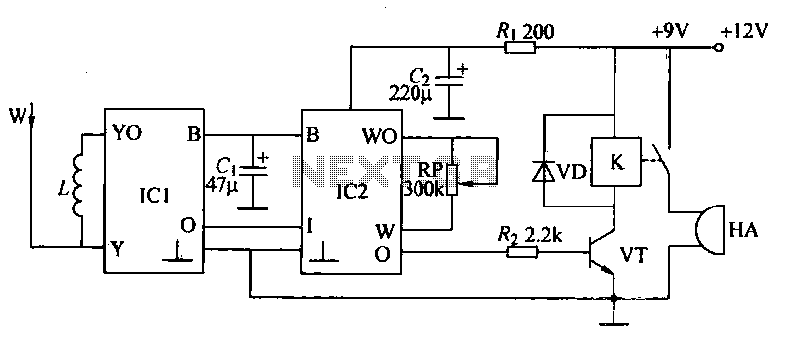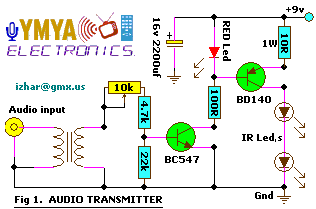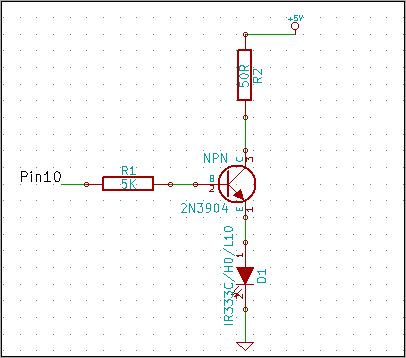
Infrared intrusion barrier
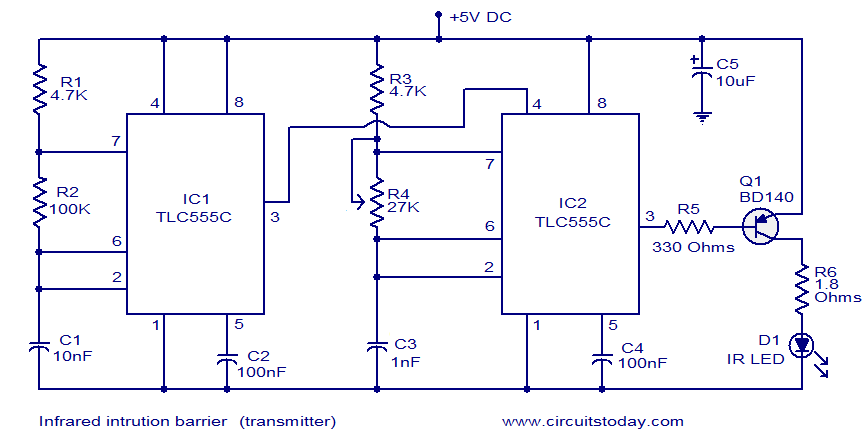
The circuit diagram of an infrared intrusion detector is presented. This system triggers an alarm when a trespasser interrupts the invisible infrared beam. It consists of a receiver circuit and a transmitter circuit. The transmitter circuit utilizes two TLC555 integrated circuits (IC1 and IC2). The first 555 timer (IC1) is configured as an astable multivibrator operating at 300 Hz, while the second 555 timer (IC2) is also configured as an astable multivibrator, operating at 36 kHz, with adjustable frequency via potentiometer R4. The output from IC1 is connected to the reset pin of IC2, resulting in IC2 generating a burst of 36 kHz pulses modulated by the 300 Hz signal. In essence, the output consists of 36 kHz pulses spaced 3 ms apart. This signal drives the base of transistor Q1, which activates the infrared LED to transmit the waveform. The receiver stage employs a TSOP1836 (IC1) infrared receiver and a TLC555C timer (IC2). When the infrared signal reaches the TSOP1836, its output becomes low, preventing the TLC555C from oscillating. This occurs because the output of the TSOP1836 is connected to the reset pin of the TLC555C, keeping the reset pin low as long as the infrared waveform is present. When the infrared waveform is interrupted by an intruder, the output of IC1 goes high, causing IC2 to begin oscillation. A piezo buzzer connected to the output of IC2 emits a sound to signal the intrusion.
The infrared intrusion detector circuit operates on the principle of modulated infrared light transmission and reception. The transmitter section, utilizing two TLC555 timers, generates a modulated infrared signal. The first timer (IC1) operates in astable mode to create a low-frequency square wave at 300 Hz, which serves as a modulation signal for the second timer (IC2). This second timer, also in astable mode, produces a high-frequency square wave at 36 kHz, which is modulated by the 300 Hz signal from IC1. This modulation results in bursts of 36 kHz pulses with a duration of 3 ms, effectively encoding the signal for transmission.
The output from IC2 is fed into a transistor (Q1), which functions as a switch to control the infrared LED. When the circuit is active, the LED emits infrared light that forms an invisible barrier. The receiver section, comprising the TSOP1836 infrared receiver, detects this modulated infrared signal. In the absence of interruption, the TSOP1836 outputs a low signal, keeping the TLC555C timer from oscillating. The connection of the TSOP1836 output to the reset pin of the TLC555C ensures that the timer remains inactive as long as the infrared beam is intact.
Upon interruption of the infrared beam by a trespasser, the output of the TSOP1836 changes to high, triggering the TLC555C timer to start oscillating. This oscillation activates the piezo buzzer connected to the output of IC2, alerting to the presence of an intruder. The design emphasizes simplicity and effectiveness in detecting unauthorized access, making it suitable for various security applications. The circuit can be further refined by adjusting component values or adding features such as adjustable sensitivity or remote notification capabilities.Here is the circuit diagram of an infrared intrusion detector. Whenever a trespasser cuts the invisible infrared beam an alarm sound will be raised. The arrangement consists of a receiver circuit and a transmitter circuit. The transmitter circuit is based on two TLC555 ICs (IC1 and IC2). The first 555 (IC1) is wired as an astable multivibrator ope rating at 300Hz. The second 555(IC2) is also wired as an astable multivibrator operating at 36 KHz which can be adjusted by using POT R4. The output of IC1 is given to the reset pin of IC2. So the output of IC2 will be a burst of 36 KHz pulses modulated by a 300Hz signal. In simple words, the output will be a burst of 36KHz pulses with a spacing of 3mS in time. This signal is fed to the base of Q1 which drives the IR LED to transmit the waveform. The receiver stage is based on a TSOP1836 (IC1) IR receiver and a TLC555C timer IC1. When the IR signal is falling on the TSOP1836, its output will be low and this prevents the TLC555C from oscillating.
This is because the output of TSOP1836 is connected to the reset pin of TLC555C and this makes the reset pin low as long there is IR waveform falling on the receiver. When the IR waveform is cut by a passing intruder, output of IC1 goes high and makes the IC2 to start oscillation.
The piezo buzzer connected at the output of IC2 sound to indicate the intrusion. We aim to transmit more information by carrying articles. Please send us an E-mail to wanghuali@hqew. net within 15 days if we are involved in the problems of article content, copyright or other problems. We will delete it soon. 🔗 External reference
The infrared intrusion detector circuit operates on the principle of modulated infrared light transmission and reception. The transmitter section, utilizing two TLC555 timers, generates a modulated infrared signal. The first timer (IC1) operates in astable mode to create a low-frequency square wave at 300 Hz, which serves as a modulation signal for the second timer (IC2). This second timer, also in astable mode, produces a high-frequency square wave at 36 kHz, which is modulated by the 300 Hz signal from IC1. This modulation results in bursts of 36 kHz pulses with a duration of 3 ms, effectively encoding the signal for transmission.
The output from IC2 is fed into a transistor (Q1), which functions as a switch to control the infrared LED. When the circuit is active, the LED emits infrared light that forms an invisible barrier. The receiver section, comprising the TSOP1836 infrared receiver, detects this modulated infrared signal. In the absence of interruption, the TSOP1836 outputs a low signal, keeping the TLC555C timer from oscillating. The connection of the TSOP1836 output to the reset pin of the TLC555C ensures that the timer remains inactive as long as the infrared beam is intact.
Upon interruption of the infrared beam by a trespasser, the output of the TSOP1836 changes to high, triggering the TLC555C timer to start oscillating. This oscillation activates the piezo buzzer connected to the output of IC2, alerting to the presence of an intruder. The design emphasizes simplicity and effectiveness in detecting unauthorized access, making it suitable for various security applications. The circuit can be further refined by adjusting component values or adding features such as adjustable sensitivity or remote notification capabilities.Here is the circuit diagram of an infrared intrusion detector. Whenever a trespasser cuts the invisible infrared beam an alarm sound will be raised. The arrangement consists of a receiver circuit and a transmitter circuit. The transmitter circuit is based on two TLC555 ICs (IC1 and IC2). The first 555 (IC1) is wired as an astable multivibrator ope rating at 300Hz. The second 555(IC2) is also wired as an astable multivibrator operating at 36 KHz which can be adjusted by using POT R4. The output of IC1 is given to the reset pin of IC2. So the output of IC2 will be a burst of 36 KHz pulses modulated by a 300Hz signal. In simple words, the output will be a burst of 36KHz pulses with a spacing of 3mS in time. This signal is fed to the base of Q1 which drives the IR LED to transmit the waveform. The receiver stage is based on a TSOP1836 (IC1) IR receiver and a TLC555C timer IC1. When the IR signal is falling on the TSOP1836, its output will be low and this prevents the TLC555C from oscillating.
This is because the output of TSOP1836 is connected to the reset pin of TLC555C and this makes the reset pin low as long there is IR waveform falling on the receiver. When the IR waveform is cut by a passing intruder, output of IC1 goes high and makes the IC2 to start oscillation.
The piezo buzzer connected at the output of IC2 sound to indicate the intrusion. We aim to transmit more information by carrying articles. Please send us an E-mail to wanghuali@hqew. net within 15 days if we are involved in the problems of article content, copyright or other problems. We will delete it soon. 🔗 External reference
